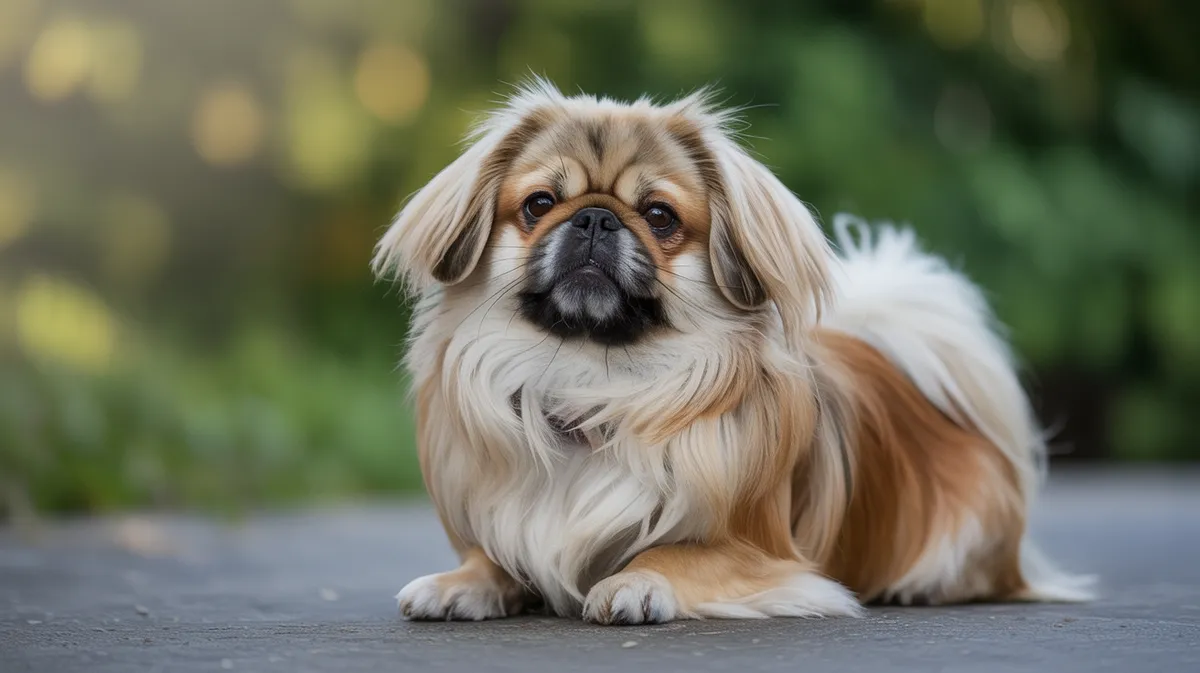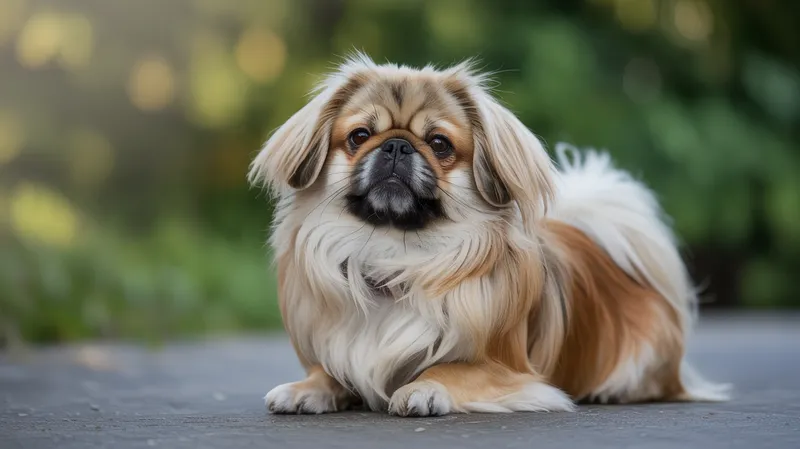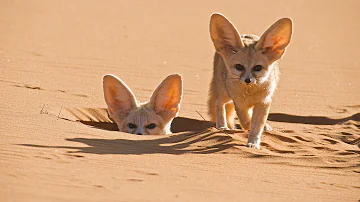
Pekingese Dog
Canis lupus familiaris

Meet the Pekingese Dog
The Pekingese is a small, regal toy breed of dog that originated in ancient China, where it was cherished by Chinese royalty for centuries. Distinguished by its long, flowing coat, compact body, and distinctive 'lion-like' mane, the Pekingese is known for its dignified and sometimes aloof personality. Despite its small size, it possesses a bold spirit and can be both affectionate and courageous. The breed is highly adaptable to indoor living, making it well-suited for city and apartment dwellers. Pekingese dogs are recognized for their loyalty to their families and their tendency to form strong bonds with their owners.
Classification
Mammal
Habitat
Domesticated/Urban
Diet
Omnivore
Lifespan
12-15 years
Conservation
Least Concern
Weight
3.2–6.4 kg (7–14 lbs)
📖Fascinating Facts
Royal Companions
Pekingese were highly prized by Chinese emperors and commoners could be executed for stealing one from the palace.
Lion-like Appearance
Their luxurious mane and confident demeanor led to their nickname 'lion dog,' a symbol of protection in Chinese culture.
Grooming Needs
Pekingese require frequent brushing and grooming due to their dense double coat, which can easily become tangled.
📋Detailed Description
The Pekingese is a compact, brachycephalic (short-nosed) toy breed, typically weighing between 3.2 and 6.4 kg (7–14 lbs) and standing 15–23 cm (6–9 inches) at the shoulder. Its most striking feature is a profuse double coat, with a long, coarse outer layer and a dense, soft undercoat, forming a distinctive mane around the neck and shoulders. The breed’s broad, flat face, large dark eyes, and pronounced stop give it a unique, expressive appearance, while the tail is set high and carried over the back in a gentle curve. Pekingese have a sturdy, muscular build beneath their luxurious fur, with a slightly bowed forelimb structure that contributes to their characteristic rolling gait. Behaviorally, they are known for their independence, intelligence, and strong-willed nature, often displaying a dignified aloofness toward strangers but deep loyalty to their owners. Socially, Pekingese are typically solitary or form strong pair bonds with humans rather than other dogs, and they may be reserved or assertive in multi-pet households. Reproductively, the breed is known for small litters (usually 2–4 puppies) and may require veterinary assistance during whelping due to their conformation. Unique adaptations include a thick coat for insulation, a flattened muzzle adapted for close human companionship, and a keen sense of hearing. Their longevity is notable, with many individuals living 12–15 years or more, provided they receive proper care.
💡 Did you know?
Legend has it the Pekingese was created by Buddha shrinking a lion down to dog size, giving rise to its 'lion dog' nickname.
🔬Research & Sources
🎭Behavior & Social Structure
Pekingese exhibit a calm, sometimes stubborn temperament, with moderate activity levels and a preference for short bursts of play followed by long periods of rest. They are not highly food-motivated but can be selective eaters, often preferring small, frequent meals. Unlike many breeds, Pekingese do not have strong hunting instincts; their feeding behavior is shaped by domestication, relying on human-provided diets. Socially, they are known for their strong attachment to a primary caregiver and may display jealousy or possessiveness. While generally tolerant of children and other pets if socialized early, they can be wary of rough handling. Pekingese are alert and make effective watchdogs, responding to unfamiliar sounds or visitors with barking. Their daily routine typically includes short walks, interactive play, and extended periods of relaxation, often in close proximity to their owners.
👶Reproduction & Life Cycle
Pekingese reach sexual maturity between 8 and 12 months of age. The breed is monoestrous, with females coming into heat approximately twice a year. Mating is often supervised due to the breed’s physical structure, and artificial insemination is sometimes employed in breeding programs. Gestation lasts about 63 days. Due to their brachycephalic anatomy and relatively large puppy heads, Pekingese frequently require cesarean sections for delivery. Litter sizes are small, averaging 2–4 puppies. Parental care is primarily provided by the dam, who nurses and grooms the puppies for the first 4–6 weeks. Breeders often assist with neonatal care to ensure puppies are feeding adequately and to monitor for respiratory issues common in flat-faced breeds.
🛡️Adaptations & Survival
The Pekingese’s dense double coat provides insulation against cold and protection from minor injuries, reflecting its origins in the cool climate of northern China. The breed’s brachycephalic skull is an adaptation to close human companionship, resulting in a shortened muzzle and large, expressive eyes that enhance social communication with people. Their compact, muscular build and low center of gravity make them surprisingly robust for their size. Behaviorally, their independence and wariness of strangers are thought to be remnants of their historical role as palace guardians. The breed’s reduced prey drive and low exercise needs are adaptations to indoor, sedentary lifestyles.
📚Research Sources
🎨Cultural Significance
The Pekingese holds a unique place in Chinese culture, where it was revered as a sacred companion of royalty and nobility for over a millennium. Legend holds that the breed originated from the union of a lion and a marmoset, symbolizing courage and dignity in a small body. Pekingese were considered imperial property, with theft punishable by death, and were often depicted in Chinese art, sculpture, and folklore. The breed was introduced to the West in the 19th century following the Second Opium War, quickly gaining popularity among European aristocracy. Today, the Pekingese remains a symbol of elegance, loyalty, and ancient heritage.
🔬Recent Research & Discoveries
Recent genetic studies have clarified the Pekingese’s relationship to other East Asian toy breeds, confirming its ancient lineage and unique genetic markers associated with brachycephaly. Ongoing research focuses on the health impacts of extreme brachycephalic features, with veterinary studies addressing airway management, heat stress, and ocular health. Advances in canine genomics are informing breeding strategies to reduce inherited disorders. Behavioral research highlights the breed’s strong attachment behaviors and its suitability as a therapy animal for elderly or sedentary individuals. The Pekingese has also been included in studies on canine cognition, demonstrating above-average problem-solving abilities for a toy breed.
🎥Wildlife Videos

Man's First Friend - The Epic Story of Dogs & Humans | Free Documentary Nature
Man's First Friend - Ths History of Dogs & Humans | Nature Documentary Watch 'Wildlife - Just Wild Dogs' here: ...
Free Documentary - Nature

Wild Dogs Everywhere: Wolves, Foxes and Coyotes
Run with packs of free spirits … the planet's Wild Dogs. This full wildlife documentary is a celebration of Canines, from howling ...
Get.factual

How Dogs Became Man's Best Friend | Free Documentary Nature
Dogs & Us - The Secret of our Friendship | Dog Documentary Watch 'Follow Your Cat - What Felines Get Up to When They Leave ...
Free Documentary - Nature

World's Smallest Wild Dog | Dogs in the Wild: Meet The Family | BBC Earth
Barely the size of a walking boot, the Fennec Fox (Vulpes zerda) goes head-to-head with the Sahara. Against all odds, the ...
BBC Earth
![Wild Dogs | National Geographic Wild Documentary [Full HD 1080p]](https://i.ytimg.com/vi/hLzJQMSZsBc/maxresdefault.jpg?sqp=-oaymwEcCOADEI4CSFXyq4qpAw4IARUAAIhCGAFwAcABBg==&rs=AOn4CLABKfWTL-ZIYEVrePsxEbJTAP4Hag)
Wild Dogs | National Geographic Wild Documentary [Full HD 1080p]
Wild Dogs | National Geographic Wild Documentary [Full HD 1080p] #wildplanet #wilddogs #documentary ----------------------- The ...
Wild Planet

An animal documentary unlike any you have seen before | The Wild Side of Dogs | Full Film
Raw and never succumbing to sentimentality or anthropomorphism. There is no music track to manipulate your feelings, instead ...
Journeyman Pictures
🌍Habitat Information
The Pekingese Dog typically inhabits Domesticated/Urban environments. Pekingese Dogs have adapted to their environments with specialized features and behaviors.
Primary Habitat:
Domesticated/Urban
More detailed habitat information will be available soon.
🛡️Conservation Status
The Pekingese Dog is currently classified as Least Concern. Conservation efforts are crucial for preserving this species for future generations.
Common Threats:
- 🏠Habitat loss and fragmentation
- 🌡️Climate change impacts
- 🎯Hunting and poaching
- 🏭Human-wildlife conflict
⚠️Threats & Conservation Challenges
As a domesticated breed, the Pekingese faces few natural threats, but it is susceptible to several health challenges. Brachycephalic airway syndrome, eye injuries (due to prominent eyes), intervertebral disc disease, and heat intolerance are common. Overbreeding and poor breeding practices have led to increased prevalence of hereditary conditions. Human impact is primarily positive, with stable or increasing population trends due to the breed’s popularity as a companion animal. However, irresponsible breeding and lack of awareness about their special care needs can negatively affect individual welfare. The breed is not at risk of extinction, but ongoing attention to health and genetic diversity is necessary.
🔬Scientific Classification
Scientific Name
Canis lupus familiaris
Classification Hierarchy
🔍 About Taxonomic Classification
Taxonomic classification is a hierarchical system used by scientists to classify and organize living organisms based on shared characteristics and evolutionary relationships.
The system moves from broad categories (Kingdom) to increasingly specific ones, with each animal's scientific name typically consisting of its Genus and species.
📝Community Notes
Share your observations and insights about the Pekingese Dog with our community of wildlife enthusiasts.
Join Our Community
Sign in to share your observations and connect with fellow wildlife enthusiasts.
Sign In to ContributeNo community notes yet
Be the first to share your observations about the Pekingese Dog!
Explore Pekingese Dog
Select a tab above to learn more about this amazing animal.
📸Photo Gallery
No photos available for this animal yet.
🌟Discover More Wildlife
Continue your journey of discovery with more fascinating animals from our database
